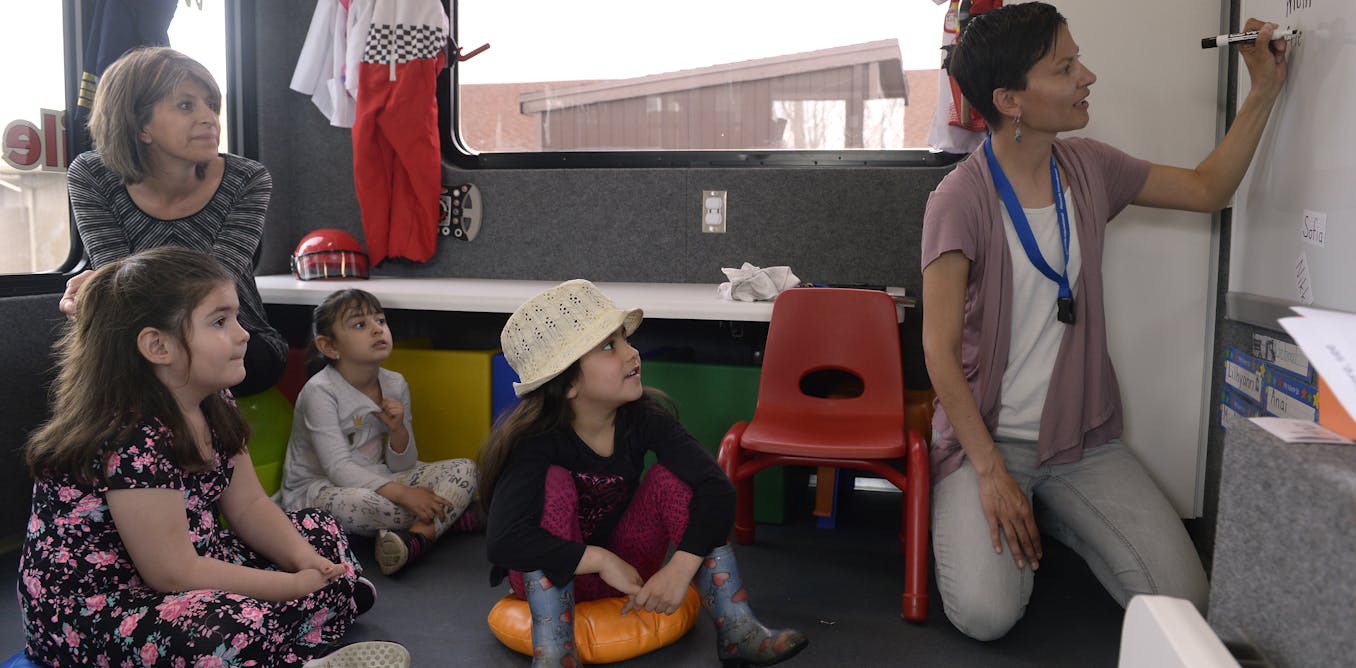A lot of research has been done on the outcomes of young children who receive care in early education programs across the country. High-quality early childhood education programs positively shape young children’s development. Far less research has focused on the early childhood workforce that powers these programs.
We set out to better understand how to support workers who care for our youngest and most vulnerable children.
Workers who provide care for children under 5, such as teachers, administrative leaders and support staff, play a pivotal role in shaping the next generation. But research suggests they are underpaid, overburdened and have limited resources.
For example, in Colorado, about 46% of the early education workforce receives public assistance, such as the Supplemental Nutrition Assistance Program benefits and Medicaid. These workers earn a median hourly pay of $18.50.
Across the country, between 43% of child care workers receive public assistance.
Additionally, teaching in early childhood settings takes a toll. According to the National Commission on Teaching and America’s Future, nearly half of early childhood education teachers report high levels of daily stress during the school year, compared with approximately 25% of U.S. workers.
Stressed-out teachers impact children, too. Poor well-being in early childhood teachers can reduce child care quality. This may lead to poor social-emotional development and increased behavioral issues in young children.
Research shows that chronic underfunding of early childhood education programs, coupled with the inherent stressors of the job, leads to burnout and turnover.
We are clinical associate and research assistant professors of public health at the Colorado School of Public Health. We have researched the early childhood education community in Colorado for more than 15 years. Our team is currently one of six federally funded national research teams investigating the well-being of this workforce and creating strategies to prevent burnout and turnover.
Mental and physical stress
There are many causes of health disparities within the early childhood education workforce. The job involves managing children’s challenging behaviors, working 9-12 hours a day, sitting in child-sized furniture, taking few breaks – and having a lack of support from co-workers and supervisors.
Michael Siluk/UCG/Universal Images Group via Getty Images
Researchers have found that early childhood educators in the U.S. experience higher rates of chronic health conditions as compared with national samples of workers with comparable income, education and other characteristics. These conditions include severe headaches, lower back pain, obesity and diabetes, as well as mental health conditions, including depression.
Past studies, including our own, suggest that poor psychological and physical well-being may be particularly pronounced among early childhood education staff employed in Head Start settings. Head Start is the largest federally funded early childhood education program in the U.S. It often provides care for young children living in poverty.
Head Start teachers report depression rates ranging between 25% and 32%, compared with the national average of 18% among the U.S. workforce.
Urban and rural teachers in Colorado
The well-being of early childhood educators also varies by where they live.
In our recent work, we explored differences in job-related demands and resources among 332 Head Start staff in rural and urban areas in Colorado.
A higher percentage of our rural sample in southeast Colorado reported lower family incomes and lower levels of education. This would suggest that early childhood education staff in rural settings may experience higher levels of stress because of increased economic hardships.
However, on average, our rural sample had a lower level of emotional exhaustion, which is a key indicator of burnout, than our urban sample.
Rural settings tend to foster close-knit relationships, strong social support networks and a slower-paced work environment than urban settings. These social situations could be why workers in rural areas report lower levels of emotional exhaustion. Alternatively, in urban settings, educators may experience larger class sizes and more stringent licensing and training standards, which could translate to increased stress.
While workers in urban settings face higher rates of burnout, we also found that they had higher levels of hope, optimism, self-efficacy and resilience than those of rural child care workers. These positive feelings helped to decrease the effects of their high-stress work environments.
Our findings suggest a need to improve the work environment and provide caregivers with healthy coping strategies – especially urban Head Start staff.
The WELL program
To address the workplace needs we identified, we launched the Well-Being of the ECE Workforce in Low-Resourced Locations program, or WELL program. The program looks at workplace policies, culture and safety, plus a person’s health status, home life and community, to create a program that supports an individual’s well-being at work.
We partnered with five Head Start agencies to test Head Start well-being programs.
The Head Start staff we worked with across Colorado identified mindfulness, coping strategies and sleep as areas of need. We tailored WELL in response to their requests. WELL provides workplace training and supports related to these topics, texts weekly tips and strategies to promote well-being, and even helps sites design a relaxation lounge as a place for staff to unwind.
Our preliminary findings suggest that the majority of staff were satisfied with the WELL program, and participants reported increased confidence in practicing behaviors that promote their well-being, like mindfulness.
“[The WELL program] has helped me within the classroom, too,” said one study participant. “So when you’re like, ‘Oh, my gosh! This child’s driving me crazy. I can’t deal with it!’ it’s like, ‘Just take a step back. It’s OK to take a break and ask somebody for help.’”
We also found that 77% felt that their early childhood education center supported participation in WELL. These findings, while preliminary, highlight the likelihood of this program to be successfully implemented in other early childhood education centers in Colorado.
Read more of our stories about Colorado.

The post “Colorado’s early childhood education workers face burnout and health disparities, but a wellness campaign could help” by Jini Puma, Clinical Associate Professor of Public Health, University of Colorado Anschutz Medical Campus was published on 04/09/2025 by theconversation.com



































Leave a Reply